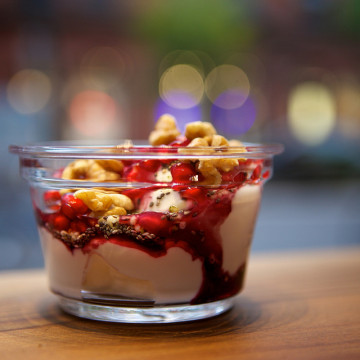Before I adopted a raw vegan lifestyle, and was eating a vegetarian diet, yogurt was one of my favorite foods. In general, I chose the Greek variety (plain, nonfat) for its thick, creamy texture and lack of the sour aftertaste I remembered hating about regular yogurt from when I was a kid. It seemed to be the perfect source of protein and calcium, and before too long I’d found ways to incorporate into any meal.
It also helped that Greek yogurt seemed to be available everywhere I turned: there were infinite flavors, brands, levels of fat content, and package sizes. You could pick up a tub to last you several days, or a single-serve cup even with add-ins like fruit and granola included. It was clearly one of the hottest health food crazes of the moment: in fact, in 2013 the Greek yogurt industry made $1.6 billion in profits, jumping up to 36% of the US market share for yogurt from a mere 1% in 2007. Chobani was even a (controversial) sponsor of the US Olympic team this year in the Sochi winter games. As the food of real-life Olympians, it’d be hard to argue against its purported health benefits.
Naturally, Greek yogurt no longer had a place in my refrigerator once I became vegan, and for a while I mourned the loss of my go-to food staple. But recent reporting on the toxicity of yogurt production, especially Greek, has given me one more reason to be grateful that I’m no longer contributing to its exponential rise.
The problem lies in the oft-overlooked byproduct of the fermentation required to make yogurt: acidic whey. Little Miss Muffet may have enjoyed this with her curds according to Mother Goose, but the average yogurt eater doesn’t care for even the slightest bit of the watery stuff that’s often found floating on the surface of a container. But that’s only a tiny fraction of the whey byproduct: The ratio of yogurt to whey per batch is about 1 to 3, which isn’t great. Last year, in the Northeast alone, over 150 million gallons of whey was produced. Yogurt companies are now faced with the challenge of how to get rid of all that whey safely. It’s inherently toxic to the environment in those high quantities, and so simply dumping it would be dangerous and illegal especially should it leech into groundwater. Companies like Chobani, located in upstate New York, have been threatened with forced closure of their factories unless they find a viable alternative.
The best options seem to be finding a way to sell or repurpose whey in small doses that living things can tolerate. There are some good proteins in whey, which can be worked into food for livestock or fertilizer. There are even attempts to use the whey, via a process called anaerobic digestion, to generate electricity.
What does this mean for vegans, though? Clearly vegans are somewhat tangential to the initial demand for whey, and its most viable recycling methods via livestock. Non-dairy yogurts also won’t produce whey during their fermentation process, since they lack the casein protein that makes whey what it is. And yet these agricultural innovations meant to solve the whey problem ultimately will have an impact on plants grown in soil, perhaps nourished by leftover milk proteins. The methane gas converted to electricity is also one of the worst offenders in greenhouse gas emissions, which are slowly eroding the ozone layer and contributing to global warming and posing threats to food sources around the world.
While there isn’t a clear answer to how vegans can avoid this conflict, and help curtail its damage other than continuing to abstain from dairy, there are some ways to respond that are healthful and environmentally conscious in their own right. Buying locally grown and organic produce will help drive attention away from large-scale farms, where whey-based fertilizer might be used. Also, be extra-wary of non-dairy substitutes, like certain cheeses, that seem vegan but actually contain casein, the milk protein found in regular dairy products.
Since the nationwide recall of Chobani in 2013 of mold-contaminated products that caused more than 400 illnesses, there seems to be rise in awareness of consumption of processed “health foods.” The future of whey is still to be decided, but in the meantime, vegans can feel somewhat relieved of steering clear of at least one more downside of eating animal products.
Also see: What You Should Know About the Hobby Lobby Case
The Decline of Honeybees and 5 Ways to Help
Also by Jennifer: Minimalist Challenge – How I Live
__
Photo: Meng He via Flickr





